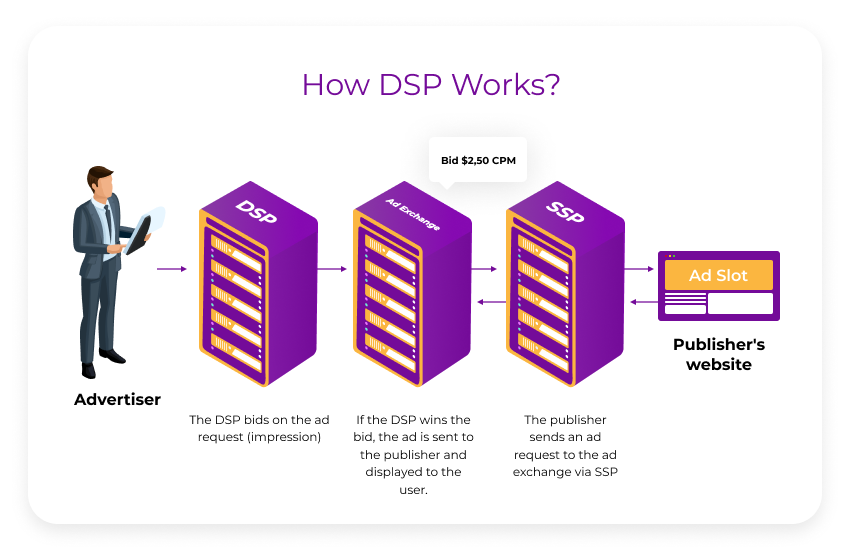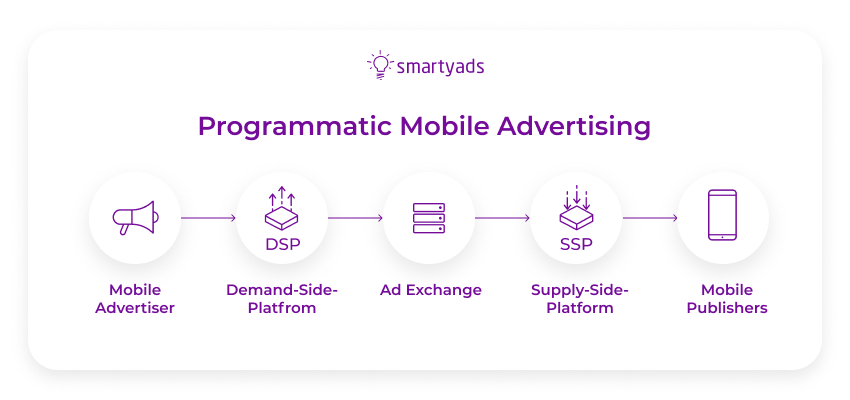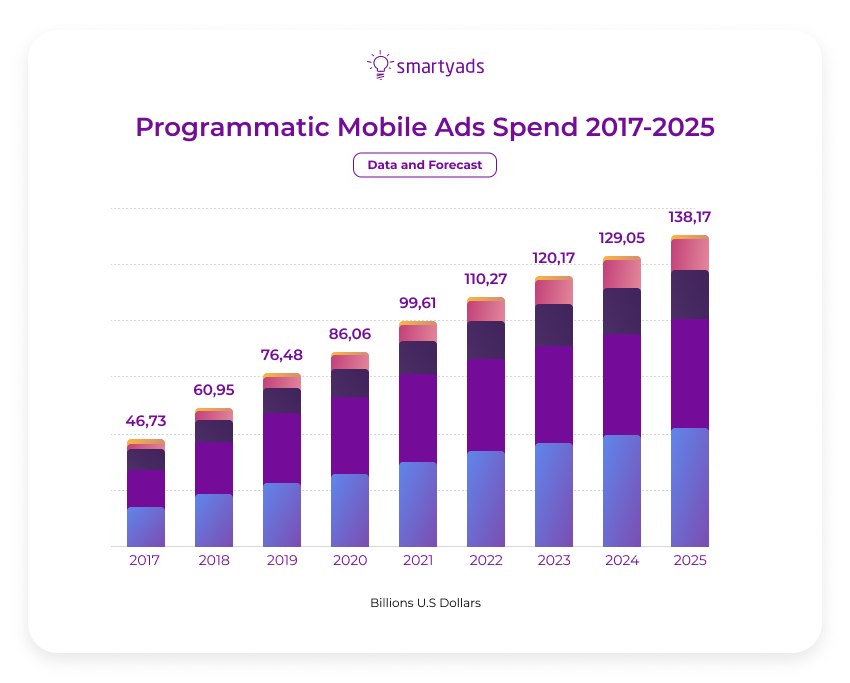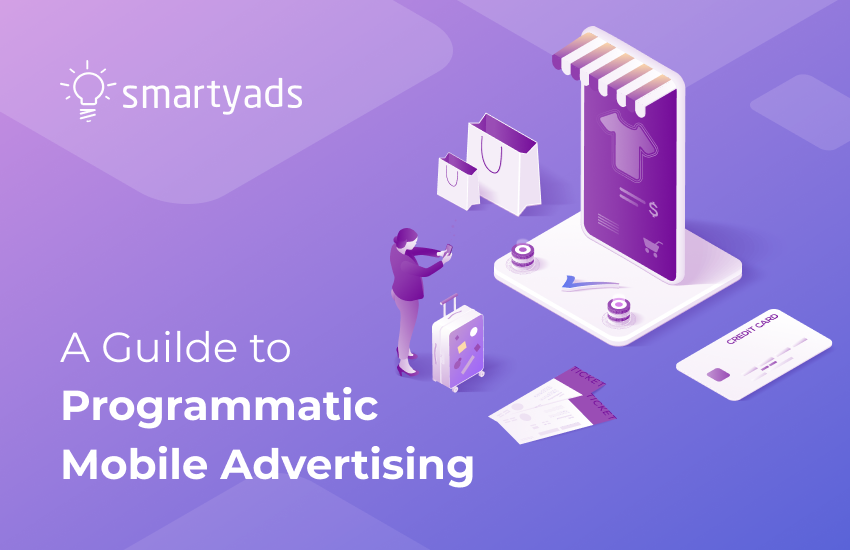Mobile programmatic advertising is one of the methods for delivering programmatic ads. Mobile advertising has taken center stage, with studies by the interactive advertising bureau indicating that marketers are allocating more than half of their budget to mobile advertising. According to another report, 91 percent of mobile device users intend to buy or have purchased goods as a result of viewing a relevant ad.
According to Siteefy, the mobile channel can generate 200% more brand interactions than all other channels combined, while emarketer says that mobile programmatic video advertisements accounted for 87% of all mobile video ads in 2021. Clearly, programmatic mobile appears to be compelling and influential, as seen by its growing popularity.
If you are considering exploring mobile programmatic strategies, or you wish to know more about programmatic ad buying, we will be showing you what you need to know and how to start with mobile programmatic advertising.

What is programmatic mobile advertising?
We cannot talk about mobile programmatic without first alluding to programmatic advertising in general. What is programmatic advertising?
Programmatic advertising is the use of automated technology to buy ad spaces and display ad creatives to end-users.
Previously advertisers had to manually search for ad spaces from publishers, then they negotiated payment terms and duration of ad campaigns. This process was time-consuming and less productive than placing ads programmatically.
Programmatic tech came to simplify and optimize the ad buying process by automatically matching advertisers with publishers through real-time bidding RTB.
Mobile programmatic refers to the automated process of buying, selling, and displaying mobile ads. in this case, the programmatic process is engaged for mobile display ads. Mobile ads can include mobile banner ads, mobile video ads, mobile native ads, etc. any form of ad optimized for mobile display is a mobile ad.
How does mobile programmatic advertising work
Mobile programmatic necessitates the cooperation of two parties: the DSP and the SSP. The first seeks for a spot to put the ad, while the second provides the space for the ad to be placed. But rather than having both sides meet to negotiate, software and other programmatic ad platforms like an advertising exchange, ad network, etc, work together to automate the entire process.
Don’t worry, we will explain the automation process subsequently. But before then, what are DSPs, SSPs, and exchanges.
What is DSP and how does it help mobile advertisers?
Mobile programmatic advertising mostly revolves around Mobile DSP (the platform that serves mobile programmatic ads). The truth is, there is no separate entity to perform the job. The Mobile DSP refers to the part of an ordinary DSP that is in charge of serving ads on mobile inventory.

Thus, if you want to manage mobile ads successfully, it is vital to get a basic understanding of the Demand Side Platform (DSP) which operates based on the real-time bidding RTB principle.
What is a demand-side platform? Demand Side Platform is an automated programmatic system for starting, running, and managing ad campaigns. Practically, it takes the form of an RTB auction or private marketplace where you can buy ad inventory in a cost-effective and data-driven manner.
You set up the parameters of your desirable targeted viewers and add the ad creatives. The rest of the invisible work is performed automatically, and you may check up real-time reports on your performance to make adjustments and retarget your mobile audiences.
What is SSP and how does it help mobile advertisers
A supply-side platform is a piece of advertising technology that automates the sale of ad inventories. They are in charge of organizing and managing ad space availability. SSPs are commonly used by online publishers to manage and sell display advertising spaces on their apps and websites.
A supply-side platform is the publisher's version of a demand-side platform. Whereas DSPs are meant to help marketers acquire ad impressions from exchanges as affordably and quickly as possible, SSPs are aimed to support mobile publishers maximize ad revenue by selling their inventories to the highest bidder.
Mobile publishers would link their inventory to multiple ad exchanges, DSPs, and networks at the same time using SSPs. As a result, multiple buyers can bid for ad space, and publishers can get the best rate.
What are ad exchanges and how do they help mobile advertisers
An advertising exchange is a type of digital marketplace that connects advertisers and publishers. The ad exchange serves as a neutral intermediary between advertisers and publishers, allowing them to buy and sell ad inventory in real-time.
DSPs connect to advertising exchanges to enable agencies and advertisers to bid on available ad inventory. Publishers also use their SSPs to link to an ad exchange, where they sell their ad slots.
Automation of programmatic advertising: how it helps mobile ad serving
The simplified structure of programmatic advertising is represented in the scheme below. It includes DSP, exchanges, and SSP (Supply-Side Platforms).

With Demand Side Platforms advertiser bids on impression automatically. Before this advertiser configures campaign settings such as the desirable ad format, size, and targeting specifics. With their help, the media buying platform knows the preferable ad impressions and selects what to bid on during the RTB auction.
With mobile programmatic advertising DSPs, you will define the characteristics according to which the system needs to target audiences: geolocation, operational system, and type of smartphone of your target audience. Whatever you need, even GPS coordinates, dayparting, and specific categories of mobile apps.
The SSPs are another essential part of the media buying and selling system. Those represent the interests of ad slots owners and, in turn, provide the specific parameters about potential viewers, their age, gender, preferences.
That kind of viewers' information goes from SSP to the data management platforms, also connected to DSP. SSP organizes ad delivery for both mobile web and in-app ecosystems (called in app advertising). The difference between those two is that in app advertising occurs to a user during any mobile application usage; mobile web ads are displayed in smartphone browsers. App developers design their applications to have slots for ads.
Regarding the real-time bidding auction, as the heart of programmatic mobile advertising, it is performed by the ad exchanges. The DSP's highest suggested bid wins the contest and receives the right to go directly to the viewer’s mobile app or mobile browser.

How big is the programmatic ad market?
Although the described process may seem a bit complicated, the programmatic advertising platform operates faster than a fraction of a second and in real-time. Such automation has made the lives of marketers, advertisers, and publishers much easier.
To realize the real coverage of mobile programmatic buying and selling, check the following statistics. In March 2021, Statista report showed that in 2020, the share of spending aimed for mobile advertising programmatic reached 83.3%. This quantity represents billions of U.S. dollars, and by the way, continuously grows. By the way, the forecast experts expect 95 billion U.S. dollars as investments to all the programmatic ads in the coming 2022.

Mobile programmatic buying deals
The types of mobile programmatic advertising deals are threefold. These are the key trends for programmatic ad buying.
With Open Marketplace (OMP)
That is an auction, open to everyone who wants to buy ad impressions. The Open Marketplace auction approach allows DSP to compete transparently and clearly, as long as everyone has the same priority and the highest bid wins. Under the OMP, we have the header bidding in the apps.
In app header bidding is a type of automated programmatic advertising for mobile app publishers. With this technology app developers can get the most out of every impression by staging an auction in which advertisers compete for impressions.
Private Marketplace Programmatic deal (PMP)
That is a closed auction, only for participants with deal ID. That helps media buyers and sellers make sure the result will correspond to the ad request at the highest level. Of course, prices here are higher since inventory is often exclusive.
Unlike open auctions, PMPs allow publishers and advertisers to collaborate more effectively. Publishers are more confident since the process is more open, giving them better control over their inventories. Advertisers also benefit from brand safety because they determine where and how their adverts are displayed.
Programmatic Guaranteed Deal (or Programmatic Direct)
That is the type that consists of direct cooperation between the buyer and the publisher. The programmatic direct is called guaranteed because the volumes of inventory and prices are fixed.
How to choose a perfect DSP for mobile?
After revealing some theoretical information related to programmatic mobile advertising, we provide you with practical tips to use in your everyday routine. Practically, DSP is the best tool to conquer the attention of mobile consumers and promote your services or goods. Whenever you decide to select mobile DSP for your business, check up the following:
The DSP vendor technical capacities
You should know as much as possible about your potential DSP architecture. The advanced platform will have great reach across mobile websites, browsers, apps, devices, and locations.
Available inventories and mobile ad formats
Currently, there are many known types of mobile units, yet the industry develops and offers new ones. Smartyads programmatic advertising DSP for mobile offers to try rich media, mobile video ads, native ad placements, dynamic and interstitial ads, and others.
Set mobile campaigns to deliver personalized messages (mobile videos, banners, natives, and other options). Make your mobile ad experience more exciting by implementing interactive ads. Check which of the DSPs can provide advertisers with good possibilities.
Real-time reports. Clarify how frequently the information updates in the performance reports regarding your mobile campaigns. That will help you to keep in touch with your statistics at any time and get ideas on what can be improved or changed.
Provided high security. Your DSP is the irreplaceable part of your mobile marketing. With the Smartyads DSP, you get guaranteed brand safety and traffic of the highest quality for your mobile campaigns.
Qualified and professional assistance. Last but surely not least, pick a service that can offer you a helping hand by a personal account manager. Although DSP is a self-serve advertising platform, It is better to optimize programmatic media buying together with a knowledgeable and experienced person. Smartyads account managers are here to help you.
Benefits of mobile programmatic advertising
Here are important benefits of mobile programmatic advertising.
More precise targeting
One notable advantage of mobile programmatic digital advertising, is the ability for more precise targeting, allowing advertisers to reach their specific audience in real-time. Advertisers can dictate right audience using certain metrics and demographics.
Great for user acquisition
More than 6 billion people use mobile devices around the world, and recent data suggest that individuals spend more time on their mobile devices than on conventional screens such as television. On the other hand, mobile app developers are not resting with over 3 million apps available on the playstore alone.
As a result, programmatic mobile advertising is an excellent channel for expanding your reach and increasing your user acquisition rate.
Relevant data and insights
Mobile programmatic advertising gives you access to relevant customer data and insights, which can help you improve your targeting and choose the ideal ad creative and ad formats for a higher conversion rate.
Transparency
The programmatic mechanism makes it easier for advertisers to track their expenditure, monitor campaign performance, and manage their ad budget. also, publishers would know what revenue their inventories are generating and the rates advertisers are paying for every impression.
Enhanced revenue
With programmatic advertising, mobile publishers are certain of enhanced and superior revenue.
The last word
Programmatic mobile advertising in the essence is very similar to other kinds of advertising - mobile ads can be supported by the same DSPs that automate the delivery of desktop or CTV ads.
Still, the mobile medium has particular differences explained by different environments the ads are served in - mobile browsers or by app advertising. The application, in particular, enables advertisers to serve highly interactive and engaging formats, including ones that are unavailable on desktop.
At this point it is important to choose a robust DSP technology that has strong targeting, reach, retargeting capabilities, traffic quality, and security, plus an impeccable service team. All of the above mentioned qualities you can find in programmatic advertising DSP from Smartyads.
Robust technology, engaging mobile formats, and friendly servicing team. If you look for these sign up at SmartyAds DSP.


.webp)


